The Karelian Autonomous Soviet Socialist Republic was established in 1923, in the Northwestern part of the RSFSR. In 1991 it was renamed the Republic of Kareliia, within the Russian Federation. Its capital is Petrozavodsk. Karelian is a Uralic language.
This is a beginning guide to bibliographic tools for researchers of Kareliia. Though not a comprehensive overview, this guide outlines three primary ways researchers can access bibliographic information about Karelian publications:
(1) Through the National Library of the Republic of Kareliia’s online library catalog
(2) Through the Russian National Library’s Department of Literature in National Languages imprint catalog
(3) Through bibliographies such as the letopis’ pechati or print chronicles for the Republic of Kareliia
Additionally, this guide highlights resources related to culture, history, language, and publishing in Kareliia.
Researchers may also want to consult the following online database for additional coverage: Elektronnyi katalog knig na iazykakh narodov RF i stran SNG on the homepage of the Russian National Library. Lastly, this guide highlights the electronic library associated with the National Library of Kareliia.
Sources: The Great Soviet Encyclopedia (Volume 11, page 445); Ethnologue.
LIBRARY CATALOGS
Natsional’naia biblioteka Respubliki Kareliia
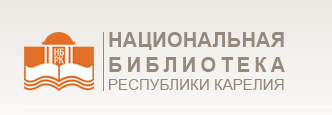
The National Library of the Republic of Kareliia has a number of different functions including supporting conservation of cultural heritage, education and intellectual work.The library’s catalog can be searched electronically (elektronnyi katalog). The period of coverage is not listed for this catalog, but it is assumed to reflect the National Library’s holdings. The electronic catalog contains information about books, journals, audiovisual materials, electronic resources, notes, documents, summary catalogs of books in local languages (including Karelian and Veps) and bibliographic databases of legal materials. Users can choose which institutions (out of a list of 38) they want to search, and within these institutions they can search particular catalogs. Users can search by a large number of categories, including at the minimum: author, title, keyword, date and place of publication. Depending on the institution chosen to search, a number of other search categories are made available. The search interface is shown in the image below.
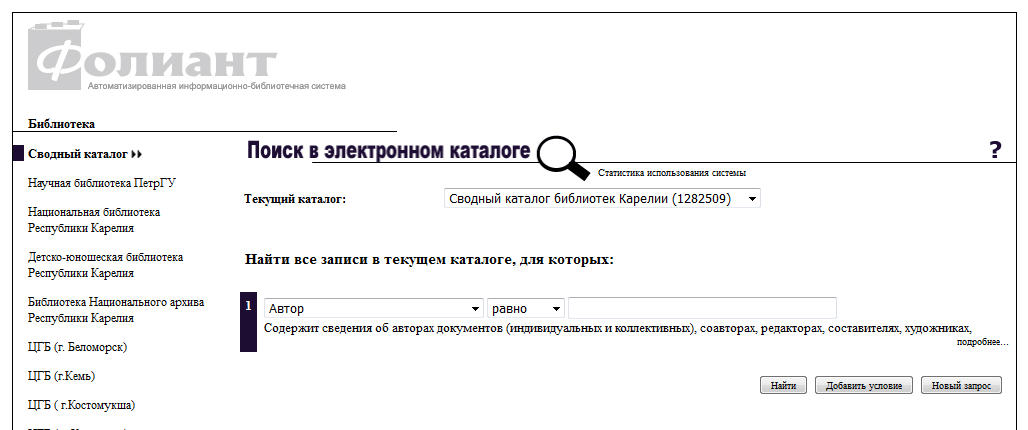
Searches will return a list of results with basic bibliographic information as is shown below.

Katalog literatury na karelʹskom yazyke [microform] Rossiĭskai︠a︡ nat︠s︡ionalʹnai︠a︡ biblioteka. Otdel literatury na nat︠s︡ionalʹnykh i︠a︡zykakh.
New York: N. Ross, 1997. U of I Library Call Number: MFICHE 016.94715 R736k International and Area Studies Library, Microfilm Room. OCLC Accession Number: 702846139.
The Russian National Library’s Department of Literature in National Languages [also known as the Department of National Literatures] of the Russian Federation, Commonwealth of Independent States, and the Baltic countries has reproduced holdings catalogs in microfiche format. The national languages imprints catalogs in microfiche format diffuse most of the difficulties associated with transliteration in the vernacular languages, spelling, forms of entry, and uncertainties with the entirety of the collection. Researchers can access the entire holdings for a specific language at the Russian National Library through the microfiche set; conveniently exporting selected titles via PDF scans. The following scans reflect some of the Karelian-language holdings available in microfiche format.
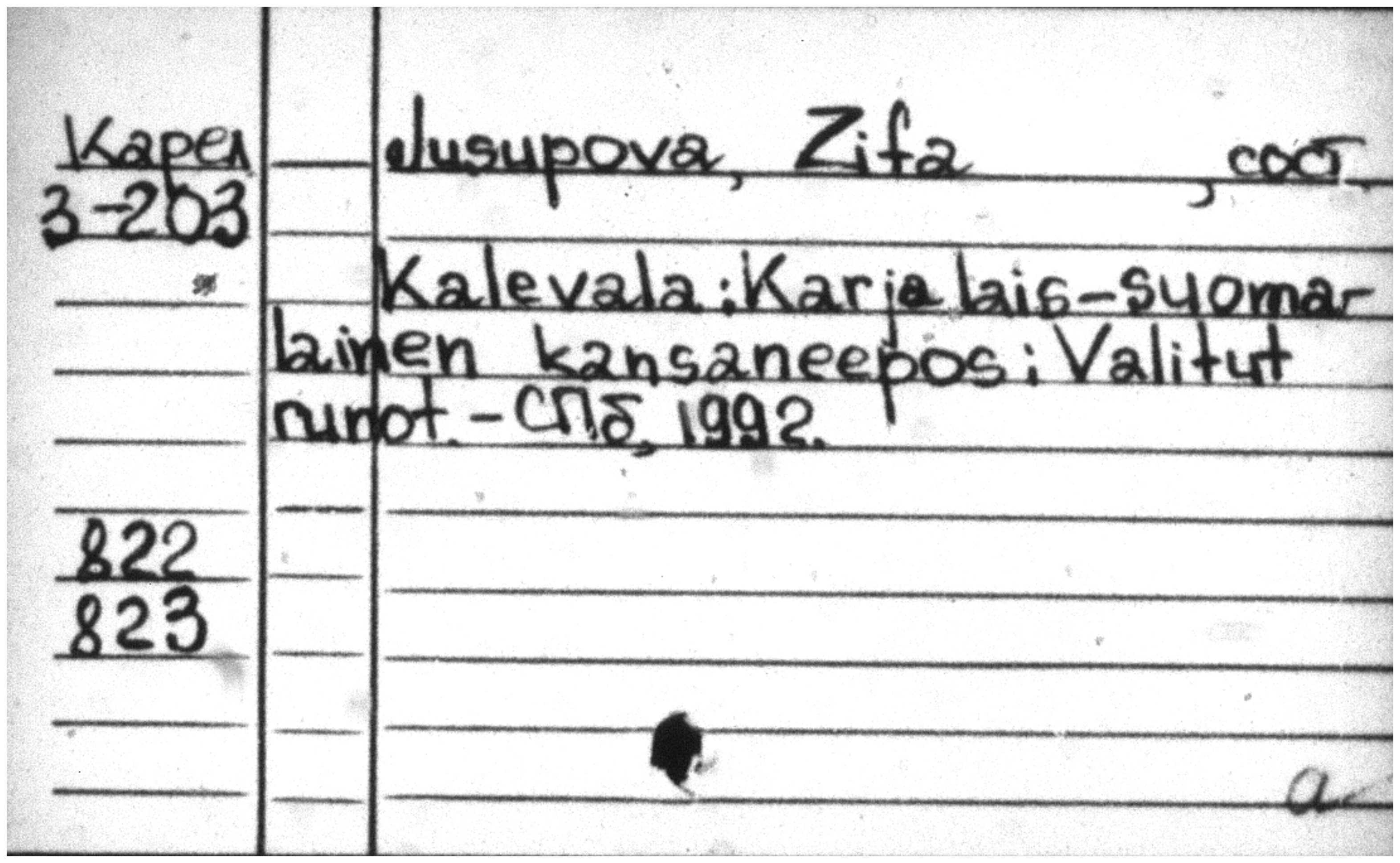
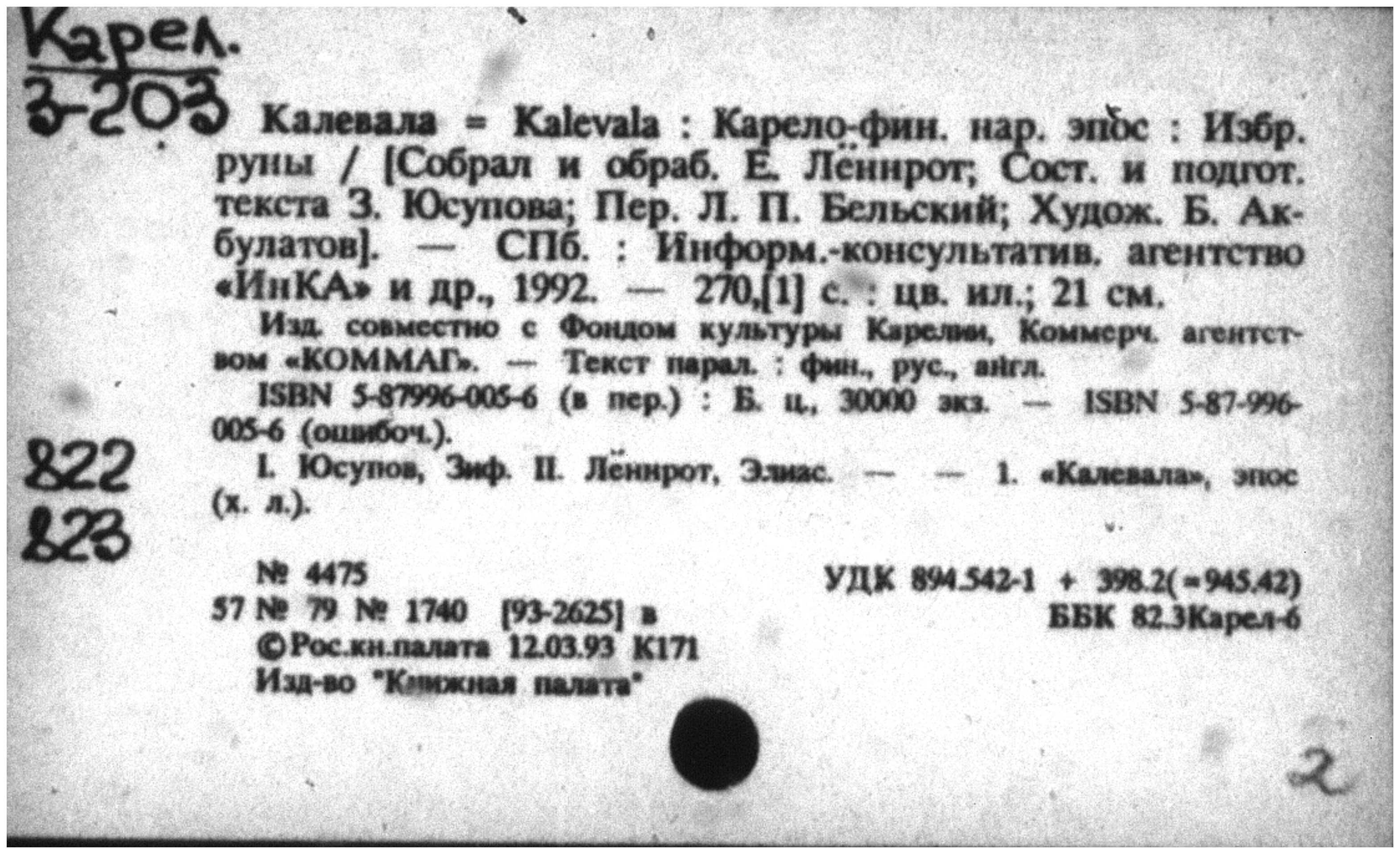
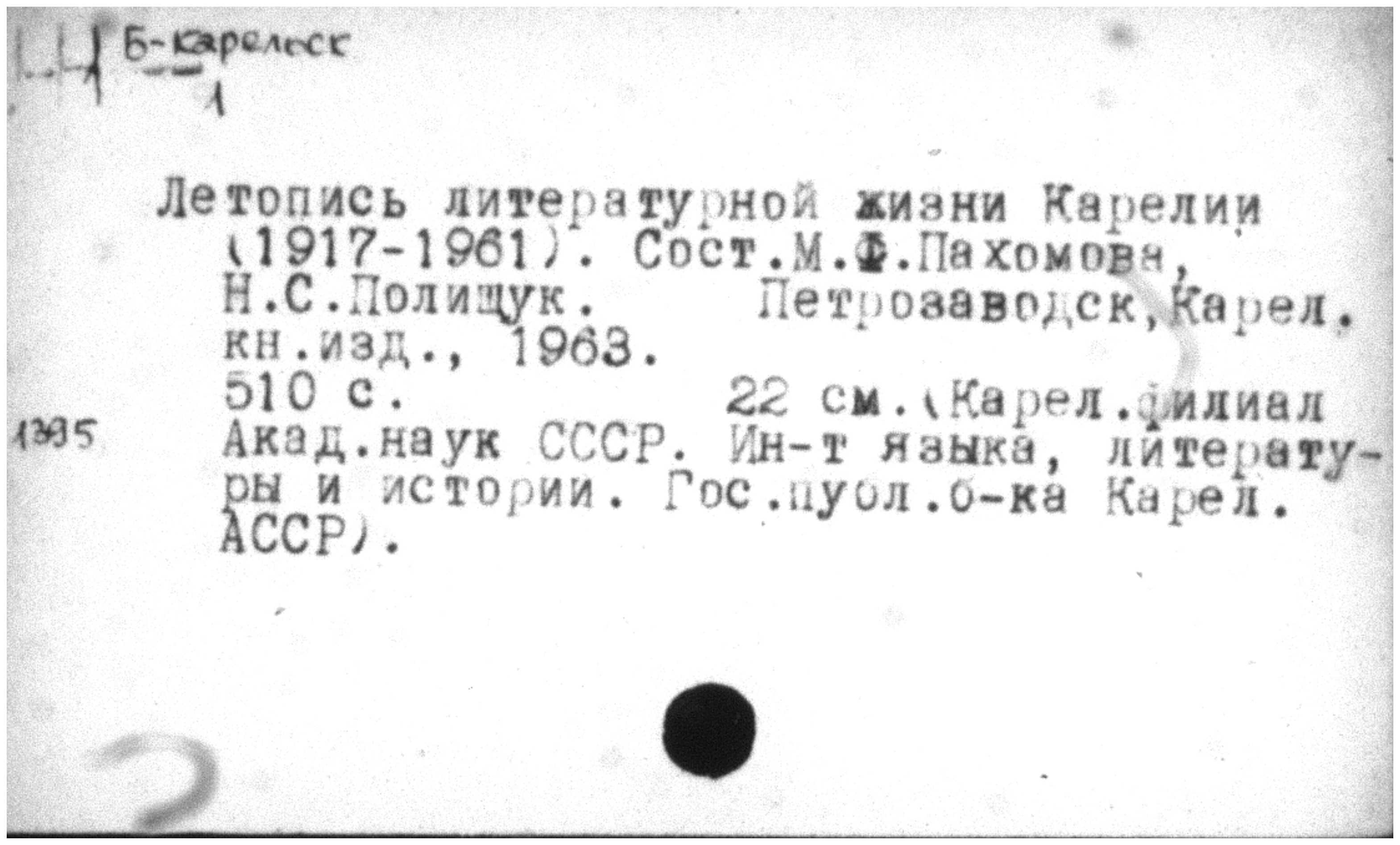
BIBLIOGRAPHIES
Letopis’ pechati and national bibliography of Kareliia
In 1959, the Book Chamber of Kareliia began to create an archive with physical copies of books, journals, newspapers, and other materials published in the republic. The archive currently includes more than 32,000 items. The Book Chamber also compiles bibliographies of these publications, and publishes them as letopis’ pechati for Kareliia: a quarterly bibliography that includes a list of all books, journal articles, newspaper articles and reviews published in Karelia for each year. Additionally, all issues include citations for publications about Kareliia in the Russian press or abroad. For select years documentation of periodicals and continuing publications by year is provided. The letopis’ pechati has been published in Kareliia since 1959. (Source: Natsional’naia biblioteka Respubliki Kareliia, “O knizhnoi palate respubliki Kareliia“)
Entry information for books includes: a general classification number given at the beginning of the section, a consecutive entry number, author, title, place of publication, publisher, date, pagination, illustrations, size, serial statement, ISBN or ISSN, number of copies printed, price and government registration number, e.g. [94-1546]. Entry information for journal and newspaper articles includes: author, title of article, title of publication and other necessary bibliographic information for citations. A sample citation listing is given in the image below.

There are four different ways in which to access the letopis’ pechati, depending on the year you want to access.
- The electronic catalog (elektronnyi katalog) of the National Library of Kareliia has citations for the letopis’ pechati from 1993-2009, but users cannot access the full text of these bibliographies online.
- The letopis’ pechati for 2009 and 2010 can be found on the Letopis’ Pechati Karelii library webpage. Users can download these documents in PDF format.
- The letopis’ pechati from 2011- present can be read on the Natsional’naia Bibliografiia Karelii website. This interface allows users to choose the year and issue they want to view and to browse by (and jump directly to) author, geographic region, subject and heading. These documents cannot be downloaded.
- Through WorldCat, users can find earlier issues of the letopis’ pechati in physical (OCLC accession number 8605536 or 36117019) and electronic form (OCLC accession number 609789645 or 742476370).
Newspapers
In 1971, 137 books and pamphlets (4,213,000 copies) and 18 newspapers (128,000 copies per issue) were published in Kareliia. The following is a list of the republic newspapers: Neuvosto-Karjala (1920) in Finnish; Leninskaia pravda (1918) in Russian; and Komsomolets (1920) in Russian. There are also nine periodicals (33,000 total circulation) including: Punalippu (1940) in Finnish; and Sever (1940) in Russian. Users can consult Gazety SSSR 1917-1960: Bibliograficheskii spravochnik 5 for a more comprehensive list of newspapers published in Karelian between 1917 and 1960.
Source: The Great Soviet Encyclopedia (Volume 11, page 445).
Other bibliographic materials
Additionally, other bibliographies and bibliographies of bibliography can be found on the Electronic Publications page (Elektronnye izdaniia) of the National Library of the Republic of Kareliia. This page also includes electronic versions of annual statistical overviews of the books, journals and newspapers published in Kareliia since 2003.
ONLINE RESOURCES
Elektronnaia biblioteka Respubliki Kareliia
The electronic library is a searchable collection of online documents available to users in full-text formats. Users can do an advanced search specifying author, keyword, publication information, title, and/or table of contents. They can also browse by author name (organized alphabetically), by topic (across both the arts and sciences), and by new arrivals.
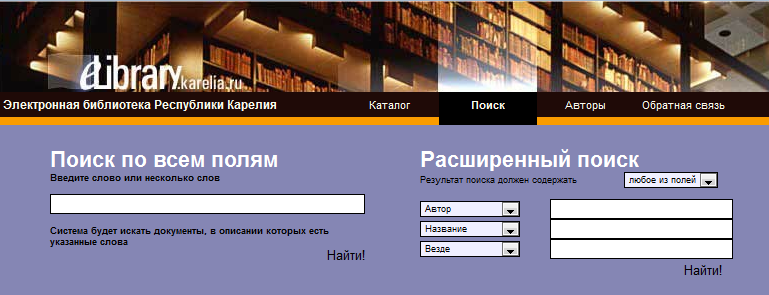
Results give a table with information about the author, the title, the date of publication and the format in which the file is available, including Word documents, PDFs, websites and scans. Sample results are shown in the image below. All formats except for scans can be downloaded and/or printed. Users will need to register and log in before they have access to the online materials. After entering basic information, users should receive email confirmation of registration almost immediately. Please note that due to maintenance issues, this website may time out. This can be corrected by refreshing the page.
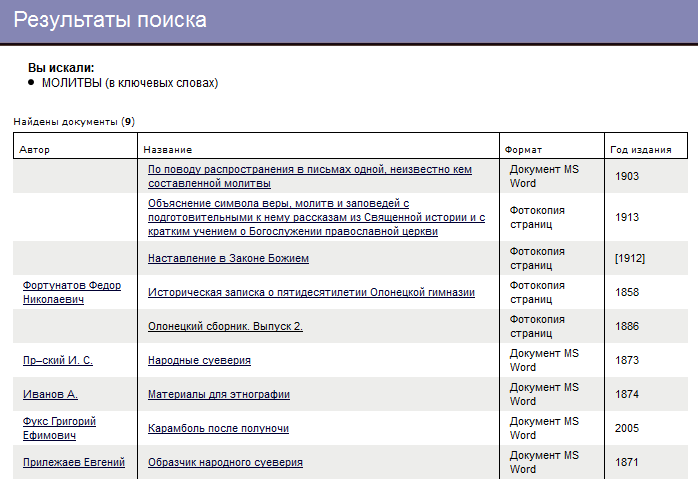
The website of the Electronic also provides links to several other online resources related to Karelian literature:
- Elektronnaia biblioteka avtorov Karelii: on this online platform, Karelian authors share their work in different formats, such as textual, graphic, and spoken form. The materials are organized by genre, such as poetry, prose, folklore, history, and children’s literature. Within these genres, the works are organized by author. The works on this website are all accessible in full-text.
- Several projects related to electronic Finno-Ugric-language collections, through the project “Finno-ugorskie biblioteki Rossii” (see below), such as Karelian, Finnish, and Veps.
Finno-ugorskie biblioteki Rossii
The platform “Finno-ugorskie biblioteki Rossii” is a collaborative project of the National Library of the Karelian Republic, the Russian and East European Institute in Helsinki, the Slavic Library of the University of Helsinki, and the M. Kastren Society. The goal of the project is to make it easier for users to navigate the different Finno-Ugric libraries in various regions of the Russian Federation and in other countries, and to create an electronic collection of publications in Finno-Ugric languages. Users can search by geographical area or by names of important figures in Finno-Ugric literature, history, and folklore. For each of the Finno-Ugric-language areas of the Russian Federation – Kareliia, Udmurtiia, Komi, Marii El, Mordoviia, Khanti-Mansiisk, Murmansk, and Tver – the website provides links to major libraries and useful library resources, a list with municipal libraries, and an overview of major educational and research institutions. For users studying Kareliia, the page with an overview of electronic publications in Karelian may be of particular interest.
The related databases Uralica and Fenno-Ugrika allow users to navigate other digitized Finno-Ugric-language materials. For users interested in more transnational research, the website of the National Library of Komi provides an overview of additional Finn-Ugric resources.
Academy of Sciences of Kareliia
The Kareliian branch of the Russian Academy of Sciences was established in 1946 in Petrozavodsk, and has become one of the major research institutions of the republic. The institute’s website provides users access to:
- An overview of the institute’s subdivisions and their research focus
- An electronic catalog that allows users to search the collection of the Scientific Library of the Karelian Academy of Sciences
- Electronic versions of the institute’s publications since 2004
- Online access to editions of the institute’s journals
information about its projects and collections, and to electronic versions of the institute’s publications.
Language and alphabet
Karelian is an Uralic language also referred to as Karelian Proper, Karel’skiy Jazyk, Karely, Severno-Karel’skij and Sobstvenno-Karel’skij-Jazyk. Until 1917 and between 1937 and 1940, the Karelian written language was based on the Cyrillic script. Between 1931 and 1939, the Latin script was used, and this has been the case again since 1989. The contemporary Karelian alphabet includes the following diacritics: Čč, Šš, Žž, Ää, and Öö. Users interested in working with vernacular languages, can download a Cyrillic extended keyboard that can be used for Karelian and many of the other national languages of the Russian Federation.